

How to knit a Ruffle Scarf and fix a knot when knitting ruffle yarn. Quoting, Paraphrasing, and Summarizing. It's Here: A new look for the Purdue OWL!

The new version of the Purdue OWL is available at Worry not! Our navigation menu and content will remain largely the same. In 11 days, we will be discontinuing owl.english.purdue.edu and you will be automatically redirected to the new site. Summary: This handout is intended to help you become more comfortable with the uses of and distinctions among quotations, paraphrases, and summaries. Contributors:Dana Lynn Driscoll, Allen BrizeeLast Edited: 2013-02-15 09:44:45 What are the differences among quoting, paraphrasing, and summarizing? These three ways of incorporating other writers' work into your own writing differ according to the closeness of your writing to the source writing. Quotations must be identical to the original, using a narrow segment of the source. Paraphrasing involves putting a passage from source material into your own words.
Summarizing involves putting the main idea(s) into your own words, including only the main point(s). APA Formatting and Style Guide. This page is brought to you by the OWL at Purdue University.
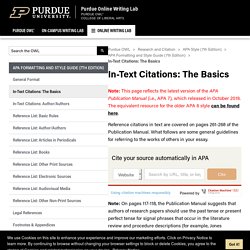
When printing this page, you must include the entire legal notice. Copyright ©1995-2018 by The Writing Lab & The OWL at Purdue and Purdue University. All rights reserved. This material may not be published, reproduced, broadcast, rewritten, or redistributed without permission. Use of this site constitutes acceptance of our terms and conditions of fair use. Avoiding Plagiarism. Summary: There are few intellectual offenses more serious than plagiarism in academic and professional contexts.
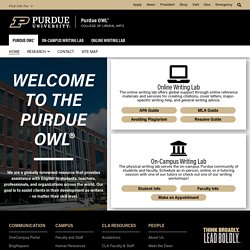
This resource offers advice on how to avoid plagiarism in your work. Contributors:Karl Stolley, Allen Brizee, Joshua M. PaizLast Edited: 2014-10-10 09:01:36 Research-based writing in American institutions, both educational and corporate, is filled with rules that writers, particularly beginners, aren't aware of or don't know how to follow. While some rhetorical traditions may not insist so heavily on documenting sources of words, ideas, images, sounds, etc., American academic rhetorical tradition does. (Purdue University students will want to make sure that they are familiar with Purdue's official academic dishonesty policy as well as any additional policies that their instructors have implemented.) Intellectual challenges in American academic writing. OWL. Contributors:Allen Brizee.Summary: This resource outlines the generally accepted structure for introductions, body paragraphs, and conclusions in an academic argument paper.

Keep in mind that this resource contains guidelines and not strict rules about organization. Your structure needs to be flexible enough to meet the requirements of your purpose and audience. The following sections outline the generally accepted structure for an academic argument paper. Keep in mind that these are guidelines and that your structure needs to be flexible enough to meet the requirements of your purpose and audience. You may also use the following Purdue OWL resources to help you with your argument paper: Introduction.
Seven stages of writing assignments. English Grammar Reference and Exercises. OWL: Verb Tenses. Summary: This handout explains and describes the sequence of verb tenses in English.

Contributors:Chris Berry, Allen Brizee, Elizabeth AngeliLast Edited: 2013-09-14 09:29:01 Strictly speaking, in English, only two tenses are marked in the verb alone, present (as in "he sings") and past (as in "he sang"). Other English language tenses, as many as thirty of them, are marked by other words called auxiliaries. Understanding the six basic tenses allows one to re-create much of the reality of time in their writing. OWL: Subject/Verb Agreement. Summary: Ever get "subject/verb agreement" as an error on a paper?
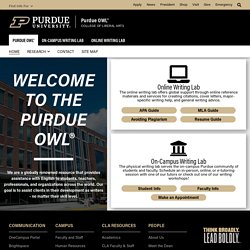
This handout will help you understand this common grammar problem. Contributors:Joshua M. Paiz, Chris Berry, Allen BrizeeLast Edited: 2014-04-01 10:34:43 This handout gives you several guidelines to help your subjects and verbs agree. 1. She and her friends are at the fair. 2. The book or the pen is in the drawer. OWL: Paraphrase Exercises. Summary: This resource discusses how to paraphrase correctly and accurately.
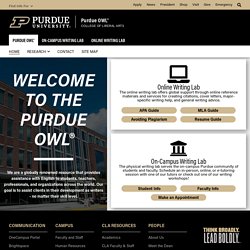
Contributors:Purdue OWLLast Edited: 2016-06-30 09:41:14 Learn to borrow from a source without plagiarizing. OWL: Creating a Thesis Statement. Summary: This resource provides tips for creating a thesis statement and examples of different types of thesis statements.
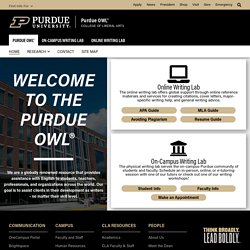
Contributors:Elyssa Tardiff, Allen BrizeeLast Edited: 2014-02-10 10:44:43 Tips for Writing Your Thesis Statement 1. Determine what kind of paper you are writing: An analytical paper breaks down an issue or an idea into its component parts, evaluates the issue or idea, and presents this breakdown and evaluation to the audience.An expository (explanatory) paper explains something to the audience.An argumentative paper makes a claim about a topic and justifies this claim with specific evidence. If you are writing a text that does not fall under these three categories (e.g., a narrative), a thesis statement somewhere in the first paragraph could still be helpful to your reader.